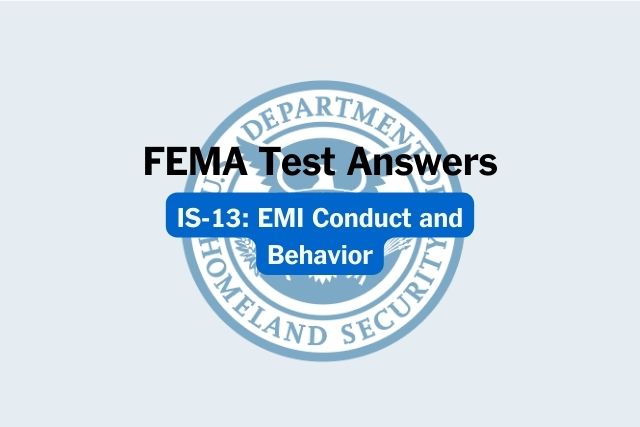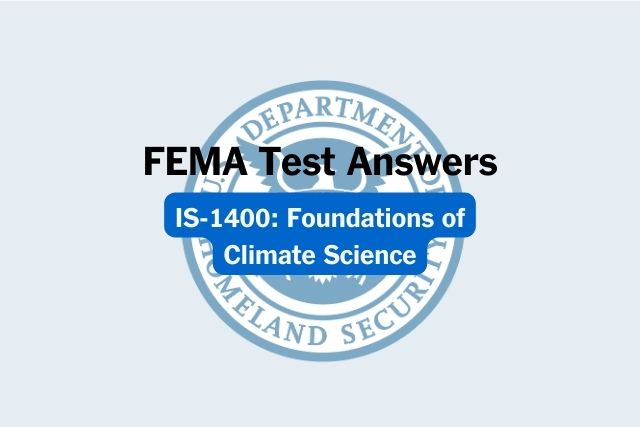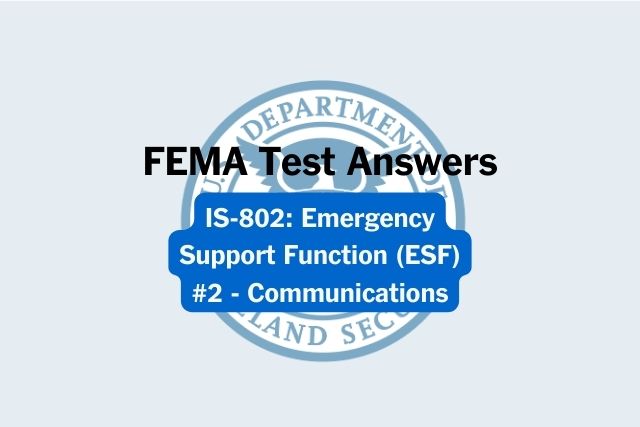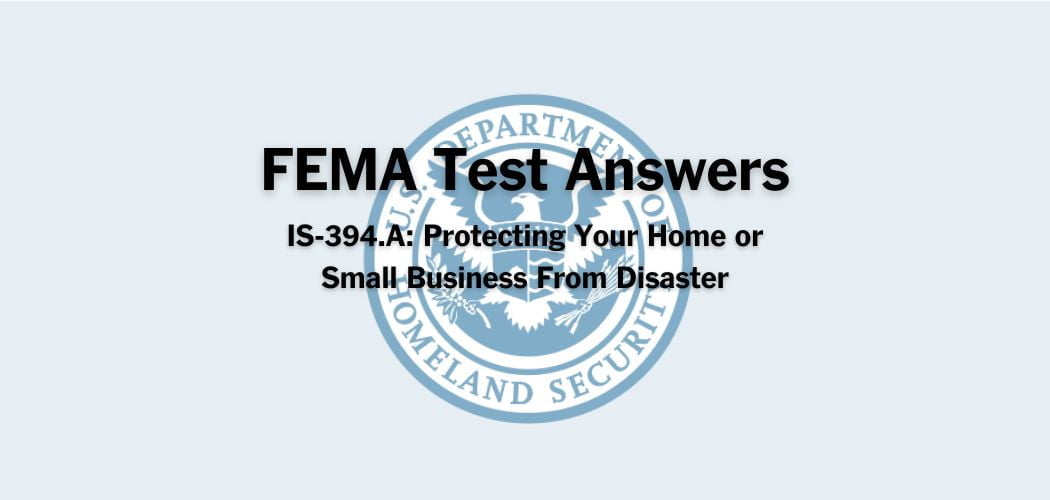Overview: The FEMA IS-238 course was published on 6/8/2022 to improve post-disaster supply chain management and strengthen understanding of local supply chain dynamics; improve information-sharing and coordination among public and private stakeholders; and provide State, Local, Tribal and Territorial Emergency Managers with the knowledge of potential and experienced post-disaster supply chain disruptions, management efforts, and best practices.
Primary audience: FEMA IS-238 is a two-hour Independent Study course that is open to all that covers the lessons learned from the 2017 hurricane season.
FEMA IS-238 test answers
Each time this test is loaded, you will receive a unique set of questions and answers. The test questions are scrambled to protect the integrity of the exam.
Question 1. A supply chain is considered _______ if it can continue moving goods and services to customers even though important elements in its network are no longer operating.
A. Resilient✅
B. Profitable
C. Aggressive
D. Vulnerable
Question 2. A supply chain is a ______ to deliver products and services from raw materials to end customers.
A. Self-sustaining, complex network of companies used✅
B. Loosely connected federation of companies that collaborate
C. Single, vertically integrated corporation designed
D. Competitive group of companies each fighting
Question 3. Companies gain a competitive advantage in the marketplace if they are able to:
A. Produce shoddy, inexpensive products.
B. Produce the widest range of products.
C. Offer their products in most locations.
D. Provide the greatest customer value.✅
Question 4. A major discount chain used a central location to consolidate vendor shipments and distribute products to individual stores in Florida. The cross-dock facility was the bottleneck in that retail supply chain. However, when Hurricane Irma approached Florida in 2017, evacuating residents consumed all the fuel at roadside gas stations and truckers would not drive into Florida for fear they would run out of gas. What happened to the bottleneck in the retail supply chain when there was a gas shortage?
A. The bottleneck shifted to the transportation node
B. The bottleneck stayed at the distribution node✅
C. The bottleneck shifted to the manufacturing mode
D. The bottleneck shifted to the retail store node
Question 5. The offer to exchange something of value for a product or service creates a:
A. Push signal that attracts suppliers.
B. Pull a signal that attracts consumers.✅
C. Push signal that attracts consumers.
D. Pull a signal that attracts suppliers.
Question 6. All disaster-related supply chain disruptions can ____ capacity and _____ lead times.
A. Increase; lengthen
B. Reduce; shorten
C. Increase; shorten
D. Reduce; lengthen✅
Question 7. The objective of any FEMA _____ is to minimize the impact of a disruptive event on the affected population and to do so as efficiently as possible.
A. Disaster relief logistical initiative✅
B. Supply chain resilience initiative
C. Parallel supply chain development initiative
D. Supply chain replacement initiative
Question 8. If a company does not have sufficient inventory stockpiled, disaster-related supply chain disruptions may _____ product delivery lead times.
A. Decrease✅
B. Stabilize
C. Increase
D. Interrupt
Question 9. Like grains of sand passing through the throat of an hourglass, products flow ___ through the bottleneck because that process stage ____.
A. Most slowly; is most inefficient
B. Most freely; has extra capacity
C. Most quickly; is most efficient
D. At the same pace; is consistent✅
Question 10. The bottleneck ___ the flow of products through the supply chain.
A. Increases
B. Slows down
C. Stops
D. Limits✅
Question 11. Setting up special-purpose relief supply chains to provide emergency goods and services after a disaster is not the best response policy because they are _____ the private sector supply chains they attempt to replace.
A. less efficient and less precise in meeting demands than✅
B. more costly and require more documentation than
C. more autonomous and more difficult to coordinate than
D. less likely to be as staff as well as
Question 12. The maximum rate at which a process stage can produce or move a product is called its:
A. Volume.
B. Velocity.
C. Capacity.✅
D. Utilization.
Question 13. Disruptions due to natural disasters, human error, and equipment breakdowns can all ____ the cycle time for a product.
A. Decrease
B. Increase✅
C. Stabilize
D. Interrupt
Question 14. An automobile supply chain begins with raw material suppliers and ends with consumers. How is the rest of the supply chain organized?
A. Automobile assembly plant, component manufacturers, car dealerships, vehicle transporters✅
B. Component manufacturers, automobile assembly plant, vehicle transporters, car dealerships
C. Car dealerships, automobile assembly plant, component manufacturers, vehicle transporters
D. Vehicle transporters, car dealerships, automobile assembly plant, component manufacturers
Question 15. Another name for inventory is:
A. Goods
B. Products
C. Backorders
D. Stock✅
Question 16. What do manufacturers call the stockpile of partially finished goods they maintain on-site for production purposes?
A. Finished goods
B. Merchandise
C. Work-in-Progress goods✅
D. Buffer inventory
Question 17. What strategy can be used to buffer the effects of disruption on a supply chain and prevent lead times from extending?
A. Provide “rain checks,” or coupons for a future purchase at the sale price.
B. Maintain inventory on hand in a retail outlet or warehouse.✅
C. Use partial shipments to reduce consumer distress.
D. Deliver directly to consumers’ homes or businesses.
Question 18. What type of supply chain resilience policy would involve hardening key production and distribution processes?
A. Response policy
B. Recovery policy
C. Mitigation policy✅
D. Readiness policy
Question 19. A bottleneck is the supply chain process that has the ____ utilization.
A. Highest
B. Lowest✅
C. Most erratic
D. Most predictable
Question 20. A new bottleneck can develop in a supply chain if:
A. Demand decreases and unneeded products pile up in warehouses.
B. An earlier stage overproduces, and the next stage can’t keep up with the increased flow.✅
C. Another process stage can’t keep up with a surge in demand.
D. Demand signals are erratic and production schedules keep changing.
Question 21. Changes in staffing levels, consumer demand, or the mix of products in a supply chain all can cause fluctuations in the ___ rate of the various process stages.
A. Capacity✅
B. Volume
C. Velocity
D. Utilization
Question 22. When a process stage is working at its highest capacity and is busy all the time, its utilization ratio is:
A. 2:1, or 200%.
B. 3:4, or 75%.
C. 1:1, or 100%.✅
D. 1:2, or 50%.
Question 23. What type of supply chain resilience policy would involve coordination among government, nongovernmental organizations, and private companies to reestablish the operations of private sector supply chains?
A. Readiness policy
B. Response policy
C. Recovery policy✅
D. Mitigation policy
Question 24. Because there is so much unpredictability in all supply chains, companies must use ___ to make supply chain decisions.
A. Supplier-supplied information
B. Influencers’ advice
C. Demand forecasts✅
D. World Bank recommendations
Question 25. Disasters can sometimes create new and more severe _____ because sudden demand shifts and capacity-reducing disruptions will increase utilization at one or more stages of the supply chain.
A. Bottlenecks
B. Product opportunities
C. Raw material shortages
D. Price increases✅
Question 26. Damage to ports, depots, roads, or bridges during a disaster can create ____ in a supply chain.
A. Communication disruptions✅
B. Demand shifts
C. Supply chain opportunities
D. Capacity reductions
Question 27. Increases to any cycle time associated with a product will _____ the lead time to the consumer.
A. Increase✅
B. Decrease
C. Stabilize
D. Interrupt
Question 28. The fundamental challenge of supply chain management is to:
A. Use the fewest nodes and links.
B. Match supply and demand.✅
C. Work within the global economy.
D. Direct the efforts of multiple companies.



